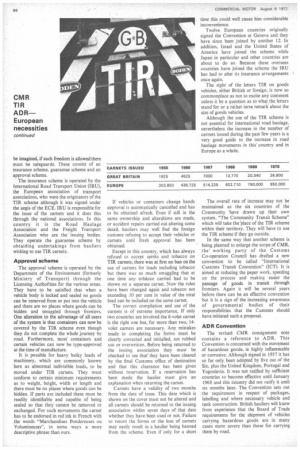CMR TIR
Page 68

If you've noticed an error in this article please click here to report it so we can fix it.
ADR European necessities
continued
be imagined, if such freedom is allowed there must be sateguards. These consist of an insurance scheme, guarantee scheme and an approval scheme.
The insurance scheme is operated by the International Road Transport Union (IRU), the European association of transport associations, who were the originators of the TIR scheme although it was signed under the aegis of the ECE. IRU is responsible for the issue of the carnets and it does this through the .national associations. In this country it is the Road Haulage Association and the Freight Transport Association who are the' issuing bodies. They operate the guarantee scheme by obtairling undertakings from hauliers wishing to use TIR carnets.
Approval scheme The approval scheme is operated by the Department of the Environment (formerly Ministry of Transport) through the Licensing Authofities for the various areas. They have to be satisfied that when a vehicle body is locked and sealed no goods can be removed from or put into the vehicle and there are no places where goods can be hidden and smuggled through frontiers. One alteration to the advantage of all users of the system is that containers can now be covered by the TIR scheme even though they do not complete the whole journey by road. Furthermore, most containers and certain vehicles can now be type-approved at the time of manufacture.
It is possible for heavy bulky loads of machinery, which are commonly known here as abnormal indivisible loads, to be moved under TIR carnets. They must conform to certain minimum requirements as to weight, height, width or length and there must be no places where goods can be hidden. If parts are included these must be readily identifiable and capable of being sealed so that they cannot be removed or exchanged. For such movements the carnet has to be endorsed in red ink in French with the words "Marchandises Pondereuses ou Volumineuses", in some ways a more descriptive phrase than ours. If vehicles or containers change hands approval is automatically cancelled and has to be obtained afresh. Even if still in the same ownership and alterations are made, or accident repairs carried out altering some detail, hauliers may well find the foreign customs refusing to accept their vehicles or carnets until fresh approval has been obtained.
Except in this country, which has always refused to accept spirits and tobacco on TIR carnets, there was at first no ban on the use of carnets for loads including tobacco but there was so much smuggling that at one time any tobacco carried had to be shown on a separate carnet. Now the rules have been changed again and tobacco not exceeding 10 per cent in value of the total load can be included on the same carnet.
The correct compilation and use of the carnets is of extreme importance, If only two countries are involved the 6-volet carnet is the right one but, for more than two, 14volet carnets are necessary. Any mistakes made in completing the forms must be clearly corrected and initialled, not rubbed out or overwritten. Before being returned to the issuing association they must be checked to see thaf they have been cleared by the final Customs office of destination and that this clearance has been given without reservation. If a reservation has been made the haulier must give an explanation when returning the carnet.
Carnets have a validity of two months from the date of issue. This date which is shown on the cover must not be altered and all carnets should be returned to the issuing association within seven days of that date whether they have been used or not. Failure to return the forms or the loss of carnets may easily result in a haulier being banned from the scheme. Even if only for a short The overall rate of increase may not be maintained as the six countries of the Community 'have drawn up their own system, "The Community Transit Scheme" which will take the 'place of the TIR scheme within their territory. They will have to use the TIR. scheme if they go outside.
In the same way that another scheme is being planned to enlarge the scope of CMR, the' working party of the Customs Co-operation Council has drafted a new convention to be called "International Customs Transit Convention" (ICT). It is aimed at reducing the paper work, speeding up the process and making easier the passage of goods in transit through frontiers. Again it will be several years before there can be an effective convention but it is a sign of the increasing awareness of governmental bodies of their responsibilities that the Customs should have initiated such a proposal.
ADR Convention The revised CMR consignment note contains a reference to ADR. This Convention is concerned with the movement of hazardous goods, ie highly inflammable or corrosive. Although signed in 1957 it has so far only been adopted by five out of the Six, plus the United Kingdom, Portugal and Yugoslavia. It was not ratified by sufficient countries to become effective until January 1968 and this Country did not ratify it until six months later. The Convention sets out the requirement in respect of packages, labelling and where necessary vehicle and tank construction. British hauliers will know from experience that the Board of Trade requirements for the shipment of vehicles carrying hazardous goods are in many cases more severe than those for carrying them by road.




























































































































